Xiaoran Liu
LongLLaDA: Unlocking Long Context Capabilities in Diffusion LLMs
Jun 17, 2025Abstract:Large Language Diffusion Models, or diffusion LLMs, have emerged as a significant focus in NLP research, with substantial effort directed toward understanding their scalability and downstream task performance. However, their long-context capabilities remain unexplored, lacking systematic analysis or methods for context extension. In this work, we present the first systematic investigation comparing the long-context performance of diffusion LLMs and traditional auto-regressive LLMs. We first identify a unique characteristic of diffusion LLMs, unlike auto-regressive LLMs, they maintain remarkably \textbf{\textit{stable perplexity}} during direct context extrapolation. Furthermore, where auto-regressive models fail outright during the Needle-In-A-Haystack task with context exceeding their pretrained length, we discover diffusion LLMs exhibit a distinct \textbf{\textit{local perception}} phenomenon, enabling successful retrieval from recent context segments. We explain both phenomena through the lens of Rotary Position Embedding (RoPE) scaling theory. Building on these observations, we propose LongLLaDA, a training-free method that integrates LLaDA with the NTK-based RoPE extrapolation. Our results validate that established extrapolation scaling laws remain effective for extending the context windows of diffusion LLMs. Furthermore, we identify long-context tasks where diffusion LLMs outperform auto-regressive LLMs and others where they fall short. Consequently, this study establishes the first context extrapolation method for diffusion LLMs while providing essential theoretical insights and empirical benchmarks critical for advancing future research on long-context diffusion LLMs.
Beyond Homogeneous Attention: Memory-Efficient LLMs via Fourier-Approximated KV Cache
Jun 13, 2025Abstract:Large Language Models struggle with memory demands from the growing Key-Value (KV) cache as context lengths increase. Existing compression methods homogenize head dimensions or rely on attention-guided token pruning, often sacrificing accuracy or introducing computational overhead. We propose FourierAttention, a training-free framework that exploits the heterogeneous roles of transformer head dimensions: lower dimensions prioritize local context, while upper ones capture long-range dependencies. By projecting the long-context-insensitive dimensions onto orthogonal Fourier bases, FourierAttention approximates their temporal evolution with fixed-length spectral coefficients. Evaluations on LLaMA models show that FourierAttention achieves the best long-context accuracy on LongBench and Needle-In-A-Haystack (NIAH). Besides, a custom Triton kernel, FlashFourierAttention, is designed to optimize memory via streamlined read-write operations, enabling efficient deployment without performance compromise.
AI Simulation by Digital Twins: Systematic Survey, Reference Framework, and Mapping to a Standardized Architecture
Jun 06, 2025Abstract:Insufficient data volume and quality are particularly pressing challenges in the adoption of modern subsymbolic AI. To alleviate these challenges, AI simulation uses virtual training environments in which AI agents can be safely and efficiently developed with simulated, synthetic data. Digital twins open new avenues in AI simulation, as these high-fidelity virtual replicas of physical systems are equipped with state-of-the-art simulators and the ability to further interact with the physical system for additional data collection. In this article, we report on our systematic survey of digital twin-enabled AI simulation. By analyzing 22 primary studies, we identify technological trends and derive a reference framework to situate digital twins and AI components. Based on our findings, we derive a reference framework and provide architectural guidelines by mapping it onto the ISO 23247 reference architecture for digital twins. Finally, we identify challenges and research opportunities for prospective researchers.
Thus Spake Long-Context Large Language Model
Feb 24, 2025Abstract:Long context is an important topic in Natural Language Processing (NLP), running through the development of NLP architectures, and offers immense opportunities for Large Language Models (LLMs) giving LLMs the lifelong learning potential akin to humans. Unfortunately, the pursuit of a long context is accompanied by numerous obstacles. Nevertheless, long context remains a core competitive advantage for LLMs. In the past two years, the context length of LLMs has achieved a breakthrough extension to millions of tokens. Moreover, the research on long-context LLMs has expanded from length extrapolation to a comprehensive focus on architecture, infrastructure, training, and evaluation technologies. Inspired by the symphonic poem, Thus Spake Zarathustra, we draw an analogy between the journey of extending the context of LLM and the attempts of humans to transcend its mortality. In this survey, We will illustrate how LLM struggles between the tremendous need for a longer context and its equal need to accept the fact that it is ultimately finite. To achieve this, we give a global picture of the lifecycle of long-context LLMs from four perspectives: architecture, infrastructure, training, and evaluation, showcasing the full spectrum of long-context technologies. At the end of this survey, we will present 10 unanswered questions currently faced by long-context LLMs. We hope this survey can serve as a systematic introduction to the research on long-context LLMs.
Capturing Human Cognitive Styles with Language: Towards an Experimental Evaluation Paradigm
Feb 18, 2025



Abstract:While NLP models often seek to capture cognitive states via language, the validity of predicted states is determined by comparing them to annotations created without access the cognitive states of the authors. In behavioral sciences, cognitive states are instead measured via experiments. Here, we introduce an experiment-based framework for evaluating language-based cognitive style models against human behavior. We explore the phenomenon of decision making, and its relationship to the linguistic style of an individual talking about a recent decision they made. The participants then follow a classical decision-making experiment that captures their cognitive style, determined by how preferences change during a decision exercise. We find that language features, intended to capture cognitive style, can predict participants' decision style with moderate-to-high accuracy (AUC ~ 0.8), demonstrating that cognitive style can be partly captured and revealed by discourse patterns.
VideoRoPE: What Makes for Good Video Rotary Position Embedding?
Feb 07, 2025
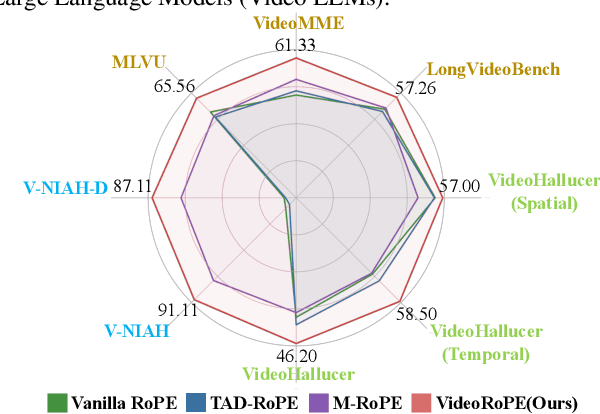
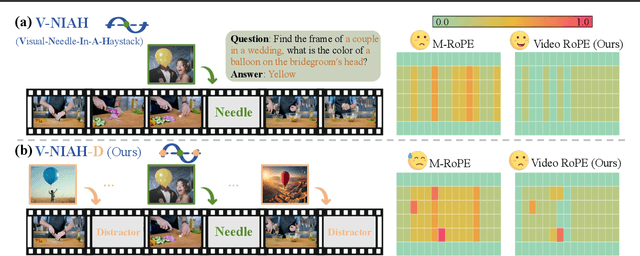
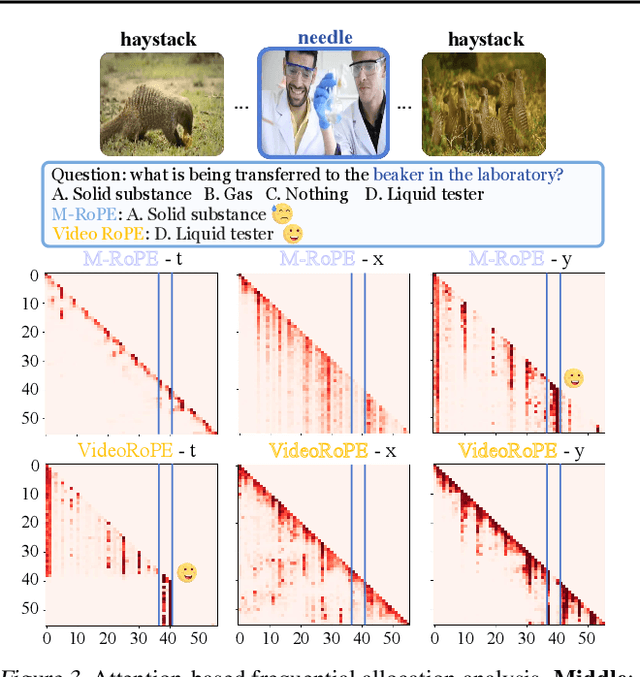
Abstract:While Rotary Position Embedding (RoPE) and its variants are widely adopted for their long-context capabilities, the extension of the 1D RoPE to video, with its complex spatio-temporal structure, remains an open challenge. This work first introduces a comprehensive analysis that identifies four key characteristics essential for the effective adaptation of RoPE to video, which have not been fully considered in prior work. As part of our analysis, we introduce a challenging V-NIAH-D (Visual Needle-In-A-Haystack with Distractors) task, which adds periodic distractors into V-NIAH. The V-NIAH-D task demonstrates that previous RoPE variants, lacking appropriate temporal dimension allocation, are easily misled by distractors. Based on our analysis, we introduce \textbf{VideoRoPE}, with a \textit{3D structure} designed to preserve spatio-temporal relationships. VideoRoPE features \textit{low-frequency temporal allocation} to mitigate periodic oscillations, a \textit{diagonal layout} to maintain spatial symmetry, and \textit{adjustable temporal spacing} to decouple temporal and spatial indexing. VideoRoPE consistently surpasses previous RoPE variants, across diverse downstream tasks such as long video retrieval, video understanding, and video hallucination. Our code will be available at \href{https://github.com/Wiselnn570/VideoRoPE}{https://github.com/Wiselnn570/VideoRoPE}.
LongSafetyBench: Long-Context LLMs Struggle with Safety Issues
Nov 11, 2024



Abstract:With the development of large language models (LLMs), the sequence length of these models continues to increase, drawing significant attention to long-context language models. However, the evaluation of these models has been primarily limited to their capabilities, with a lack of research focusing on their safety. Existing work, such as ManyShotJailbreak, has to some extent demonstrated that long-context language models can exhibit safety concerns. However, the methods used are limited and lack comprehensiveness. In response, we introduce \textbf{LongSafetyBench}, the first benchmark designed to objectively and comprehensively evaluate the safety of long-context models. LongSafetyBench consists of 10 task categories, with an average length of 41,889 words. After testing eight long-context language models on LongSafetyBench, we found that existing models generally exhibit insufficient safety capabilities. The proportion of safe responses from most mainstream long-context LLMs is below 50\%. Moreover, models' safety performance in long-context scenarios does not always align with that in short-context scenarios. Further investigation revealed that long-context models tend to overlook harmful content within lengthy texts. We also proposed a simple yet effective solution, allowing open-source models to achieve performance comparable to that of top-tier closed-source models. We believe that LongSafetyBench can serve as a valuable benchmark for evaluating the safety capabilities of long-context language models. We hope that our work will encourage the broader community to pay attention to the safety of long-context models and contribute to the development of solutions to improve the safety of long-context LLMs.
DetectiveQA: Evaluating Long-Context Reasoning on Detective Novels
Sep 04, 2024Abstract:With the rapid advancement of Large Language Models (LLMs), long-context information understanding and processing have become a hot topic in academia and industry. However, benchmarks for evaluating the ability of LLMs to handle long-context information do not seem to have kept pace with the development of LLMs. Despite the emergence of various long-context evaluation benchmarks, the types of capability assessed are still limited, without new capability dimensions. In this paper, we introduce DetectiveQA, a narrative reasoning benchmark featured with an average context length of over 100K tokens. DetectiveQA focuses on evaluating the long-context reasoning ability of LLMs, which not only requires a full understanding of context but also requires extracting important evidences from the context and reasoning according to extracted evidences to answer the given questions. This is a new dimension of capability evaluation, which is more in line with the current intelligence level of LLMs. We use detective novels as data sources, which naturally have various reasoning elements. Finally, we manually annotated 600 questions in Chinese and then also provided an English edition of the context information and questions. We evaluate many long-context LLMs on DetectiveQA, including commercial and open-sourced models, and the results indicate that existing long-context LLMs still require significant advancements to effectively process true long-context dependency questions.
Farewell to Length Extrapolation, a Training-Free Infinite Context with Finite Attention Scope
Jul 21, 2024



Abstract:The maximum supported context length is a critical bottleneck limiting the practical application of the Large Language Model (LLM). Although existing length extrapolation methods can extend the context of LLMs to millions of tokens, these methods all have an explicit upper bound. In this work, we propose LongCache, a training-free approach that enables LLM to support an infinite context with finite context scope, through full-context cache selection and training-free integration. This effectively frees LLMs from the length extrapolation issue. We validate LongCache on the LongBench and L-Eval and demonstrate its performance is on par with traditional full-attention mechanisms. Furthermore, we have applied LongCache on mainstream LLMs, including LLaMA3 and Mistral-v0.3, enabling them to support context lengths of at least 400K in Needle-In-A-Haystack tests. We will improve the efficiency of LongCache by GPU-aware optimization soon.
InternLM2 Technical Report
Mar 26, 2024
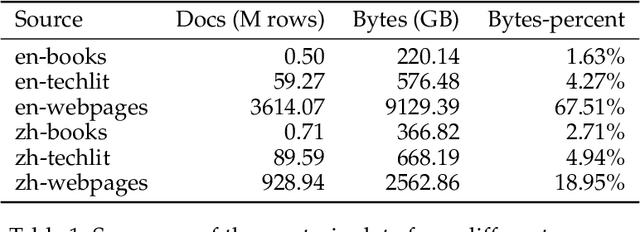
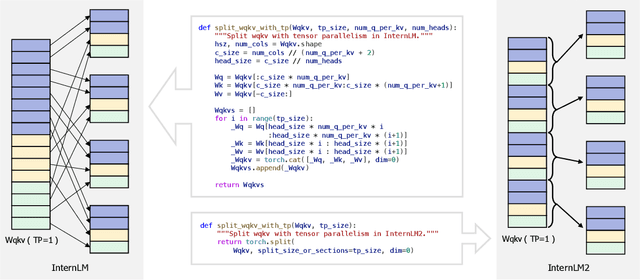

Abstract:The evolution of Large Language Models (LLMs) like ChatGPT and GPT-4 has sparked discussions on the advent of Artificial General Intelligence (AGI). However, replicating such advancements in open-source models has been challenging. This paper introduces InternLM2, an open-source LLM that outperforms its predecessors in comprehensive evaluations across 6 dimensions and 30 benchmarks, long-context modeling, and open-ended subjective evaluations through innovative pre-training and optimization techniques. The pre-training process of InternLM2 is meticulously detailed, highlighting the preparation of diverse data types including text, code, and long-context data. InternLM2 efficiently captures long-term dependencies, initially trained on 4k tokens before advancing to 32k tokens in pre-training and fine-tuning stages, exhibiting remarkable performance on the 200k ``Needle-in-a-Haystack" test. InternLM2 is further aligned using Supervised Fine-Tuning (SFT) and a novel Conditional Online Reinforcement Learning from Human Feedback (COOL RLHF) strategy that addresses conflicting human preferences and reward hacking. By releasing InternLM2 models in different training stages and model sizes, we provide the community with insights into the model's evolution.
 Add to Chrome
Add to Chrome Add to Firefox
Add to Firefox Add to Edge
Add to Edge